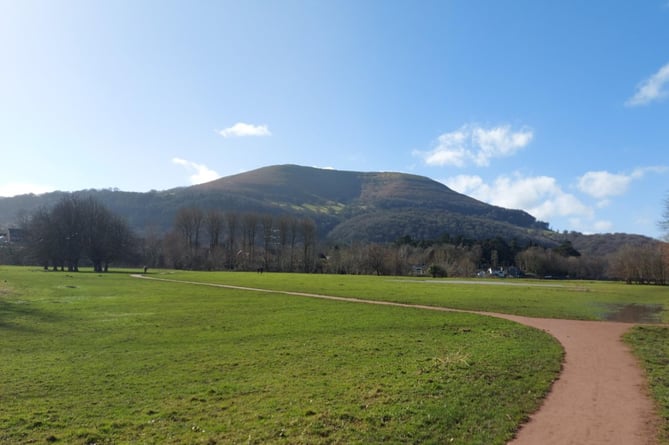FOLLOWING on from last week’s Chronicle headline and feature, Friends of Castle Meadows (FCM) welcome the long awaited publication of the plans for the proposed footbridge over the River Usk. It should make the route from Llanfoist to Abergavenny much safer for all residents and visitors.
However, we have a number of concerns regarding the proposals for the 22 hectare floodplain meadows themselves and which form the major part of Monmouthshire County Council’s planning application.
These relate to the council’s and their project contractor’s plans for the pathways which are supposedly designed to better enable active travel from the new bridge to the town and to the railway station. Our concerns are focussed around the proposed extensions to the current routes, their additional width, and their proposed composition. We also have strong reservations about the proposed access and egress arrangements in the application.
Firstly, as a group we are still baffled as to why the council decided that no EIA (Environmental Impact Assessment) was necessary for a project of this magnitude in such an environmentally valuable and sensitive site. The total pathway route area to be developed amounts to nearly 0.95 of a hectare, which amounts to about two rugby pitches.
In other words, over 9,000 square metres of this precious habitat will be affected by the development, and the new routes will clearly cut a visibly jarring swathe through the whole of the proposed area .
Secondly, the proposal is that the new and replacement pathways be at least three metres wide in order to be compliant with Active Travel Wales requirements where there is mixed use (walkers, cyclists etc.) and, therefore, qualify for the Welsh Government grant monies.
We do not believe that the applicants have made any attempt to query whether the general stipulation that such paths be at least three metres wide should apply in such an environmentally valuable location, one which runs alongside an SSSI.
It’s also of note that where the site’s logistics do not enable this width e.g. from the castle to the copse entrance to the meadows where an ancient wall stands, the council has had to plan for a 2 metre width only, and all in an area which is very steep. In addition, the requirement that the cycle route must be three metres will mean the demolition of the relatively recently built footbridge over the River Gavenny and its replacement. Really? And at what cost?
Our third concern is the proposed composition of the pathways. The present grasscrete/stonedust surfaces are permeable. This enables floodwater to be absorbed into the ground and to not create further flooding problems downstream.
However, according to the ‘Application for Planning Permission’ document (PP-11318417) the proposal is that ‘hard bound surfacing’ should be used comprising a ‘combination of surfaces, including gravel’. This will have to include components which have damaging environmental consequences and which, we feel, will almost certainly breach the 2016 Environment Act.
Very high temperatures (now more likely) can cause the release of polluting chemicals from the surface, including tiny particles PM2.5 which are some of the most dangerous types of air pollution for human health. Such surfaces, when hot, also buckle and become pitted, especially by wheeled users, and are likely to crack and form hollows where water will puddle, any hard surface will be clogged by mud and other debris after each flood.
Its compacting will inevitably mean its ability to drain way floodwater will be severely diminished. It’s also proposed that kerb edging be used, and this will further lead to pooling and the likelihood of walker and cycling stumbles.
The other serious concern FCM has is the proposals for access and egress to the meadows.
In order to (mainly) enable cyclists a continuous, speedy throughway, it is proposed that existing gate arrangements be removed and that a wider, slow closing gate be installed along with cattle grids.
It has been a maddening aspect of this planning project that some key council personnel have not properly seen the site for what it actually is i.e. a rare, lowland floodplain meadow and not a ‘park’, as has been uttered by some of them in meetings. And what makes it such a biodiverse space is that it is managed as regenerative farmland by a farmer leasing the land. Cattle (Welsh Blacks) graze and fertilise the land from late summer to January, and then from February to August the grass is allowed to grow for hay making.
As such it is vital that this arrangement continue, but with more and more grazing land likely to be taken away, kerbed path edging etc. it is not a given.
The cattle grids are, therefore, proposed to keep the cattle from straying onto the roads. Interestingly, a delayed trial of this scheme is due to take place around now i.e. when the cattle are off the site.
Presumably the council can then say that in the trial no cattle escaped. All this will mean easier access to the meadows which will make it so much more likely that all sorts of motorised vehicles will be able to enter the site and enjoy the three metre width hard bound pathways. If this happens then it will not just be the cattle affected, but the vast majority of users who enjoy the tranquility and escape presently offered in Castle Meadows.
That the farmer has barely been consulted about all this is, sadly, typical of the entire process. And it shows, with just one example of many from the planning documents referring to the contractors planting trees and shrubs in places which we can see are inappropriate and will, anyway, be swept away by flooding and/or nibbled away by cattle-guarded or not. It is also proposed that perfectly good, mature trees near the copse are to be felled because they might overhang at certain times of the year!
As a volunteer group, the Friends of Castle Meadows have devoted tens of thousands of hours to the meadows, planting trees and shrubs, arranging bird, bat, moth and other nature walks, organising visits for local school children with activities based on the national curriculum etc. etc.
We have worked for over a decade with Monmouthshire County Council to help maintain and manage the site (often using our own raised funds to do so) for the benefit of local people and visitors.
Our local knowledge and views, along with the farmer’s and other key personnel, have not been sought and suggestions have largely been ignored.
Our Friends group include mobility scooter users and keen cyclists so we are fully aware of the need for continuous, smooth surfaces in the Meadows . But we also know how valuable the area is as a destination in and of itself for the hundreds of walkers, dog walkers and other users on a daily basis.
Monmouthshire County Council (not to be confused with Abergavenny Town Council) might claim that there is some support for the proposal, but the skewed ‘do you think the route through the meadows should be improved’ nature of the survey was only ever designed to comply with Active Travel plan requirements and monies for cycle route purposes.
We would urge everyone who knows, loves and uses this wonderful space to view the full proposals on the MCC Planning Application website and to comment on them before the 28th February.
Friends of Castle Meadows.




